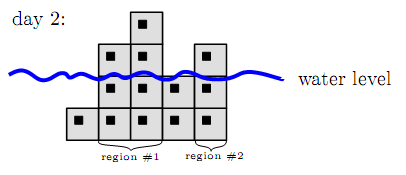CEPC08B - SkyScrapers
In a seaside village, there is an avenue of skyscrapers. Each skyscrapers is 100m wide and has certain height. Due to very high price of parcels, any two consecutive skyscrapers are adjacent. The avenue lies close to the beach so the street is exactly at the sea level. Unfortunately, this year, due to the global warming, the sea level started to increase by one meter each day. If the skyscraper height is no greater than the current sea level, it is considered flooded. A region is a maximal set of non-flooded, adjacent skyscrapers. This term is of particular importance, as it is sufficient to deliver goods (like current, carrots or cabbages) to any single skyscraper in each region. Hence, the city major wants to know how many regions there will be in the hard days that come. An example of an avenue with 5 skyscrapers after 2 days is given below.

Input
The input contains several test cases. The first line contains an
integer t
(t ≤ 15) denoting the number
of test cases. Then t
test cases follow. Each of them begins with a line containing two
numbers n
and
d (1 ≤ n, d
≤ 106), n
is the number of skyscrapers and d
is the number of days which the major wants
to query. Skyscrapers are numbered from left to right. The next line
contains n integers h1, h2,
. . . , hn
where 1 ≤ hi ≤ 109 is the
height of skyscraper i.
The third line of a single test case contains d numbers
tj such that 0 ≤ t1
< t2 < . . . < td−1
< td ≤ 109.
Output
For each test case output d numbers r1, r2, . . . , rd, where rj is the number of regions on day tj .
Example
Input: 2 3 3 1 2 3 1 2 3 5 3 1 3 5 1 3 0 2 4 Output: 1 1 0 1 2 1
hide comments
|
|
thanos_tapras:
2020-03-25 18:41:06
Really nice problem! Be careful handling the queries. Last edit: 2020-03-25 18:41:33 |
|
|
Divanshu:
2013-08-21 12:12:20
O(NlogN) passes with I/O optimisations! Strict time limit! |
|
|
Raghavendran Ramachandran:
2012-09-25 17:29:19
Using scanf and STL sort, I get TLE.
|
|
|
Efim:
2011-12-19 09:51:07
My (n log n) passed only after IO optimizations. |
|
|
Ravi Kiran:
2010-05-06 07:05:56
I got tle with C++ 4.0.0.8 but ac with C++ 4.3.2!
|
|
|
Ostry:
2009-12-20 14:57:20
I'm having TLE all the time. Even when removing all my code (only data input functions remaining). There must be sth wrong with their input. |
|
|
~!(*(@*!@^&:
2009-08-04 00:03:04
so, dont sort :) |
|
|
Mateusz Dereniowski:
2009-06-03 19:47:28
Cause, the right sentence is: "I have tle cause I sort." ;) |
|
|
Przemys³aw Derengowski:
2009-06-01 23:00:55
Why limits are so hard?? I have sort and tle :/ Last edit: 2009-06-02 04:53:30 |
|
|
Tomasz Wasilczyk:
2009-05-25 18:25:06
Limits are very stict: my first solution, with my own input reading and using qsort() had TLE. It get finally passed after replacing qsort() with sort(). |
| Added by: | Robert Rychcicki |
| Date: | 2008-12-06 |
| Time limit: | 1.160s |
| Source limit: | 50000B |
| Memory limit: | 1536MB |
| Cluster: | Cube (Intel G860) |
| Languages: | All except: ERL JS-RHINO NODEJS PERL6 VB.NET |
| Resource: | Central European Regional Contest 2008 |

 RSS
RSS